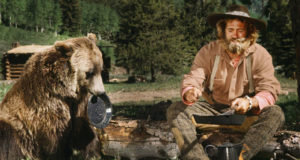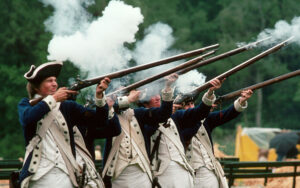Pity the poor American farmer. Since the 18th century, he has been freighted not simply with growing crops or raising animals, but with carrying the virtue of the American republic. Thomas Jefferson said so himself, writing that: “Those who labor in the earth are the chosen people of God, if ever He had a chosen people, whose breasts He has made His peculiar deposit for substantial and genuine virtue.”
He believed that independent yeoman farmers were the only Americans capable of preserving the new nation’s morals and keeping it from “corruption”. Since then, the American family farm has always stood for a way of life — the best way of life, in fact — and it has been venerated almost religiously. A heavy burden indeed.
That the aristocratic Jefferson never once harnessed up a plow and instead relied on slave labour to do all his farming for him was, at one level, a fitting irony. The small family farmer Jefferson conjured was always more myth than reality and became more so over the decades. Along the way, the myth has woven itself into the national DNA. According to a 2018 survey by Gallup, more than a quarter of Americans wish they could live on a farm. Fewer than 1.5% of us actually do.
In fact, farmers tend to be a minority in rural areas. Roughly 25% of America’s population is classed as rural, which means that most rural people are doing something other than farming. They drive long-haul trucks; they are members (or retired) members of the military; they work for local or state government; they work in manufacturing plants which have emerged in farm fields since the Sixties. These folks, however, have not become part of our rural mythos.
Jefferson’s myth of the yeoman farmer was turned into national policy in 1862 when Congress passed the Homestead Act, which offered any American 160 acres of land for free, provided the land was farmed for five years. Between 1862 and 1890 an area larger than Great Britain came under cultivation as white settlers gobbled up land that had been cleared by the U.S. Army of its original inhabitants.
But as they rushed to take advantage of this giveaway, farmers did not behave the way Jefferson rhapsodised that they would. Far from being “independent”, American farmers relied on the Federal government in all sorts of ways, particularly to provide them with water through big dam and irrigation projects in the West. Nor was self-sufficiency their goal. They farmed to make as much money as they could, and from the outset they were tied to national and international commodities markets. By the 1880s, more than 30% of those homestead farmers had mortgaged their land to raise more capital. Far from standing in some virtuous opposition to Big City financiers, farmers helped to pioneer the instruments of modern finance capitalism.
Perhaps more than anything else, however, the family farm industrialised rapidly and dramatically. The Jeffersonian fantasy pitted the pastoral as the opposite of the industrial — but American farmers saw no such distinction. They eagerly purchased the latest industrial devices to make farming easier. The John Deere corporation, maker of all sorts of farm equipment, was founded in 1837, and its last reported revenue statement (2022) topped $52 billion. In 1865, when the Civil War ended, it took 61 hours of labour to produce an acre of wheat; by 1900 that time had dropped to three hours thanks to labour-saving technology. In the Twenties, International Harvester — another vast farm machinery producer — ran an ad campaign around the theme “Every Farm a Factory”.
The industrialisation of farming, made possible by its financialisation, has had two predictable results: farming itself required less and less labour, and farms got bigger and bigger in a quest for efficiencies of scale. As early as 1910, the US Census reported significant population loss from farming areas in the middle of the country, and that exodus of people continued across the 20th century. The 1960 Census, to take another example, reported that of the 1,520 counties in the 18 states that roughly constitute the national midsection, from Mississippi and Louisiana to North Dakota, Montana, and Minnesota, 61% lost population during the previous decade; this figure rose to 92% in the counties of Arkansas.
Industrialisation has also led to the consolidation of farms. The number of farming operations peaked in 1935 at about seven million. Now the figure stands at two million. As a result, the average size of an American farm is 445 acres, roughly twice the size of the average in the UK (215 acres). But even that figure is a bit misleading because of the way farms are counted in the first place. If we look at individual states in the nation’s farm belt, the numbers get much bigger: in Kansas, the average is now 780 acres; Nebraska, 1,000 acres; in Montana, over 2,100 acres. A farmer in part of rural Ohio told me a few years ago that, if you wanted to make a full-time living here, you need at least 2,000 acres. “Get big or get out!” Earl Butz, Secretary of Agriculture under Richard Nixon, liked to tell farmers, and one wonders what Jefferson would have made of him.
That’s partly why I’m not sure we ought to even use the word “farm” anymore. It’s an old word, which elides as much as it describes. The kind of set-up it describes — with a homestead at its centre, animals raised for family consumption in the barn, crops grown for market — disappeared more than half a century ago at least. As one Illinois farmer described it: “General farming belongs to our past. . .When I was a child, of course we had pigs, and put down the pork in brine for the winter, and of course we had chickens, and cows. . . . Orchards [were] plowed under to make room for more beans. That’s what we grow now, soy beans and corn.” That was in 1957.
Farming, as it is practised in the United States today, is more aptly described as industrial calorie production. To call 1,500 acres of corn, genetically modified to withstand harsh chemical pesticides and intended for a high-fructose corn syrup plant, a “farm” is a bit like calling a highly automated Ford factory a “workshop”.
The distance between the myth of the family farm and the realities of American agriculture explains why we often speak of a farm “crisis” in the United States, and we have done so for over a century. Farmers became charity cases in 1985. Inspired by the Live-Aid rock festival to benefit Ethiopian famine victims, Willie Nelson, Neil Young and John Mellencamp organised Farm Aid to raise money for families losing their farms. The Farm-Aid fundraising project continues to this day, and its website boasts: “Farm Aid has raised more than $78 million to promote a strong and resilient family farm system of agriculture.”
That distance between myth and reality is also, I believe, at the root of the increasingly conservative, increasingly angry politics found in some (but certainly not all) rural areas. Of course, measured against the pastoral myth, with all of its redeeming and moral power, any reality is bound to come up short. But a sense of disappointment has become acute in economically distressed rural areas and in the small towns that once served as the social and economic centres of agrarian hinterlands. Drive through these places and you’re likely to find nothing but a bar and a pizza shop left on the Main Street, as other shops are put out of business by a ginormous Walmart 10 miles away. Much of rural and small-town America can be seen by those who live there as landscapes of loss. In these places and under those circumstances, who wouldn’t yearn to make America great again?
But as the Farm Aid website suggests, the Jeffersonian myth persists. Many Americans continue to believe that the small-scale “family farm” is at the heart of American agriculture, and even more politicians parrot that rhetoric. This celebration of the family-farm fantasy is one of the few remaining tropes shared by both political parties.
The Farm Bill, a vast, sprawling, and expensive piece of legislation, is up for renewal during this legislative session. Whatever its final details, it will undoubtedly provide an almost bottomless grab-bag of subsidies and other goodies for industrial-scale agricultural producers, as it has for the last 50 years. I’m guessing, however, that the elected officials who will shape the legislation will sing the song of the American family farm yet again, and voters will cheer in genuflection. This is a myth that will not die.
Disclaimer
Some of the posts we share are controversial and we do not necessarily agree with them in the whole extend. Sometimes we agree with the content or part of it but we do not agree with the narration or language. Nevertheless we find them somehow interesting, valuable and/or informative or we share them, because we strongly believe in freedom of speech, free press and journalism. We strongly encourage you to have a critical approach to all the content, do your own research and analysis to build your own opinion.
We would be glad to have your feedback.
Source: UnHerd Read the original article here: https://unherd.com/




